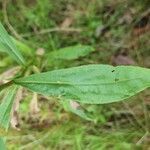Plants 3–12 dm from a stout, branched caudex or short rhizome, commonly with ± deep-seated creeping rhizomes as well, essentially glabrous, or sometimes ± short-hirsute on the lvs or in the infl; lvs basally disposed, the larger ones 15–40 × 2–7.5 cm, with rather narrowly elliptic-acuminate, ± serrate blade tapering to the long petiole; infl dense, mostly about as broad as long, with recurved-secund branches; invol 3–5 mm; rays 7–12, minute; disk fls 9–14; receptacle with some slender, chaffy, phyllary-like bracts near the margin internal to the rays; achenes short-hairy; 2n=18. Dry, open places and open woods, especially in sandy soil; N.S. and N.B. to Minn., s. to Va., Tenn., ne. Miss., Mo., and in the mts. to n. Ga. and n. Ala.






